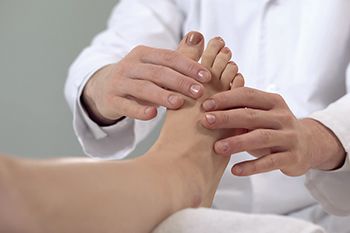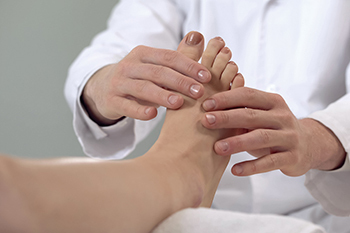Connect With Us
Blog
Items filtered by date: September 2022
Treating Plantar Fasciitis

Plantar fasciitis is a common foot affliction and source of heel pain. The condition is caused by inflammation of the plantar fascia, which is a band of tissue running along the arch of the foot. There are many ways that a podiatrist might recommend treating plantar fasciitis. For example, more conservative treatment options might include performing stretches/exercises, wearing a foot splint, wearing arch supports, or taking anti-inflammatory drugs. In other cases, effective treatment options might include shock wave therapy, which utilizes sound waves to stimulate the plantar fascia. A cortisone injection might even be attempted once to address cases of plantar fasciitis. In more severe cases, a surgical procedure might help treat a case of plantar fasciitis. If you have this foot condition, contact a podiatrist today.
Plantar fasciitis can be very painful and inconvenient. If you are experiencing heel pain or symptoms of plantar fasciitis, contact Dr. Eddy Caldwell from Foot Care of Northeast Arkansas, P.A.. Our doctor can provide the care you need to keep you pain-free and on your feet.
What Is Plantar Fasciitis?
Plantar fasciitis is the inflammation of the thick band of tissue that runs along the bottom of your foot, known as the plantar fascia, and causes mild to severe heel pain.
What Causes Plantar Fasciitis?
- Excessive running
- Non-supportive shoes
- Overpronation
- Repeated stretching and tearing of the plantar fascia
How Can It Be Treated?
- Conservative measures – anti-inflammatories, ice packs, stretching exercises, physical therapy, orthotic devices
- Shockwave therapy – sound waves are sent to the affected area to facilitate healing and are usually used for chronic cases of plantar fasciitis
- Surgery – usually only used as a last resort when all else fails. The plantar fascia can be surgically detached from the heel
While very treatable, plantar fasciitis is definitely not something that should be ignored. Especially in severe cases, speaking to your doctor right away is highly recommended to avoid complications and severe heel pain. Your podiatrist can work with you to provide the appropriate treatment options tailored to your condition.
If you have any questions please feel free to contact our office located in Jonesboro, AR . We offer the newest diagnostic and treatment technologies for all your foot and ankle needs.
What Is Morton’s Neuroma?

Morton’s neuroma is a nerve condition that causes severe pain in the ball of the foot. It usually involves damage to the nerves that run between the third and fourth toes. Some link the feeling to that of having a small pebble in their shoe. The tissue around the nerve becomes thickened which can cause burning pain in the ball of the foot that radiates to the toes. Morton’s neuroma may also cause numbness and tingling. Many believe that wearing high-heeled shoes is a factor in the development of Morton’s neuroma. Some relief may be found by switching to footwear with a lower heel and a wider toe box. Other treatment options include rest, pain medication, orthotics, and injections. In severe cases, surgery may be necessary. If the pain in the ball of the foot persists or gets worse, it is wise to visit a podiatrist for an exam as well as more advanced treatment options.
Morton’s neuroma is a very uncomfortable condition to live with. If you think you have Morton’s neuroma, contact Dr. Eddy Caldwell of Foot Care of Northeast Arkansas, P.A.. Our doctor will attend to all of your foot care needs and answer any of your related questions.
Morton’s Neuroma
Morton's neuroma is a painful foot condition that commonly affects the areas between the second and third or third and fourth toe, although other areas of the foot are also susceptible. Morton’s neuroma is caused by an inflamed nerve in the foot that is being squeezed and aggravated by surrounding bones.
What Increases the Chances of Having Morton’s Neuroma?
- Ill-fitting high heels or shoes that add pressure to the toe or foot
- Jogging, running or any sport that involves constant impact to the foot
- Flat feet, bunions, and any other foot deformities
Morton’s neuroma is a very treatable condition. Orthotics and shoe inserts can often be used to alleviate the pain on the forefront of the feet. In more severe cases, corticosteroids can also be prescribed. In order to figure out the best treatment for your neuroma, it’s recommended to seek the care of a podiatrist who can diagnose your condition and provide different treatment options.
If you have any questions, please feel free to contact our office located in Jonesboro, AR . We offer the newest diagnostic and treatment technologies for all your foot care needs.
Heel Pain Can Be Treated!
The Benefits of Custom Orthotics

Orthoses, commonly called orthotics, are inner soles that are placed in the shoes. Some types are prefabricated and available for purchase in retail stores, and others are custom-made by a podiatrist. Research has shown that custom orthotics are generally more helpful in reducing foot pain and correcting other foot issues. If you have tried store-bought orthotics and are not finding relief, it may be time to consult a podiatrist. A foot examination may include testing the range of motion, muscle strength, and bone structure. Your walking pattern, which is known as the gait, will be assessed, along with a discussion of what may be causing the pain you are experiencing. Other factors, such as the type of shoes that are worn, lifestyle choices, activities, and work conditions will be considered. A cast or scan is then taken, and the orthotic is crafted specifically for your foot. This may address toe and foot deformities, arch problems, gait abnormalities, and heel problems. For more information on custom orthoses, please consult a podiatrist.
If you are having discomfort in your feet and would like to try orthotics, contact Dr. Eddy Caldwell from Foot Care of Northeast Arkansas, P.A.. Our doctor can provide the care you need to keep you pain-free and on your feet.
What Are Orthotics?
Orthotics are inserts you can place into your shoes to help with a variety of foot problems such as flat feet or foot pain. Orthotics provide relief and comfort for minor foot and heel pain but can’t correct serious biomechanical problems in your feet.
Over-the-Counter Inserts
Orthotics come in a wide variety of over-the-counter inserts that are used to treat foot pain, heel pain, and minor problems. For example, arch supports can be inserted into your shoes to help correct overarched or flat feet, while gel insoles are often used because they provide comfort and relief from foot and heel pain by alleviating pressure.
Prescription Orthotics
If over-the-counter inserts don’t work for you or if you have a more severe foot concern, it is possible to have your podiatrist prescribe custom orthotics. These high-quality inserts are designed to treat problems such as abnormal motion, plantar fasciitis, and severe forms of heel pain. They can even be used to help patients suffering from diabetes by treating foot ulcers and painful calluses and are usually molded to your feet individually, which allows them to provide full support and comfort.
If you are experiencing minor to severe foot or heel pain, it’s recommended to speak with your podiatrist about the possibilities of using orthotics. A podiatrist can determine which type of orthotic is right for you and allow you to take the first steps towards being pain-free.
If you have any questions please contact our office located in Jonesboro, AR . We offer the newest diagnostic and treatment technologies for all your foot and ankle needs.
Diagnosing a Broken Foot

One should always take a broken foot seriously. When someone breaks or fractures the foot, they may experience a wide range of unpleasant symptoms. For example, the individual might notice a sensation of tenderness, a loss of feeling around the affected area, visible changes to the skin like bruising or swelling, and a cracking sound whenever the foot is moved. A medical professional, such as a podiatrist, can help diagnose your broken foot in different ways. For example, a simple examination of your foot might be performed whereby skin breaks and foot movement are analyzed. Additionally, to diagnose your broken foot, an X-ray, MRI, or CT scan might be performed. Through these procedures, pictures are taken of the affected foot with the aid of contrast liquid. This kind of liquid essentially improves how visible your foot will be in a picture. Lastly, to diagnose your broken foot, a medical professional may perform what is known as a bone scan. No matter how a diagnosis is performed, you should contact a podiatrist if you suspect a broken foot. A podiatrist will help you identify and treat the problem.
A broken foot requires immediate medical attention and treatment. If you need your feet checked, contact Dr. Eddy Caldwell from Foot Care of Northeast Arkansas, P.A.. Our doctor can provide the care you need to keep you pain-free and on your feet.
Broken Foot Causes, Symptoms, and Treatment
A broken foot is caused by one of the bones in the foot typically breaking when bended, crushed, or stretched beyond its natural capabilities. Usually the location of the fracture indicates how the break occurred, whether it was through an object, fall, or any other type of injury.
Common Symptoms of Broken Feet:
- Bruising
- Pain
- Redness
- Swelling
- Blue in color
- Numbness
- Cold
- Misshapen
- Cuts
- Deformities
Those that suspect they have a broken foot shoot seek urgent medical attention where a medical professional could diagnose the severity.
Treatment for broken bones varies depending on the cause, severity and location. Some will require the use of splints, casts or crutches while others could even involve surgery to repair the broken bones. Personal care includes the use of ice and keeping the foot stabilized and elevated.
If you have any questions please feel free to contact our office located in Jonesboro, AR . We offer the newest diagnostic and treatment technologies for all your foot and ankle needs.






